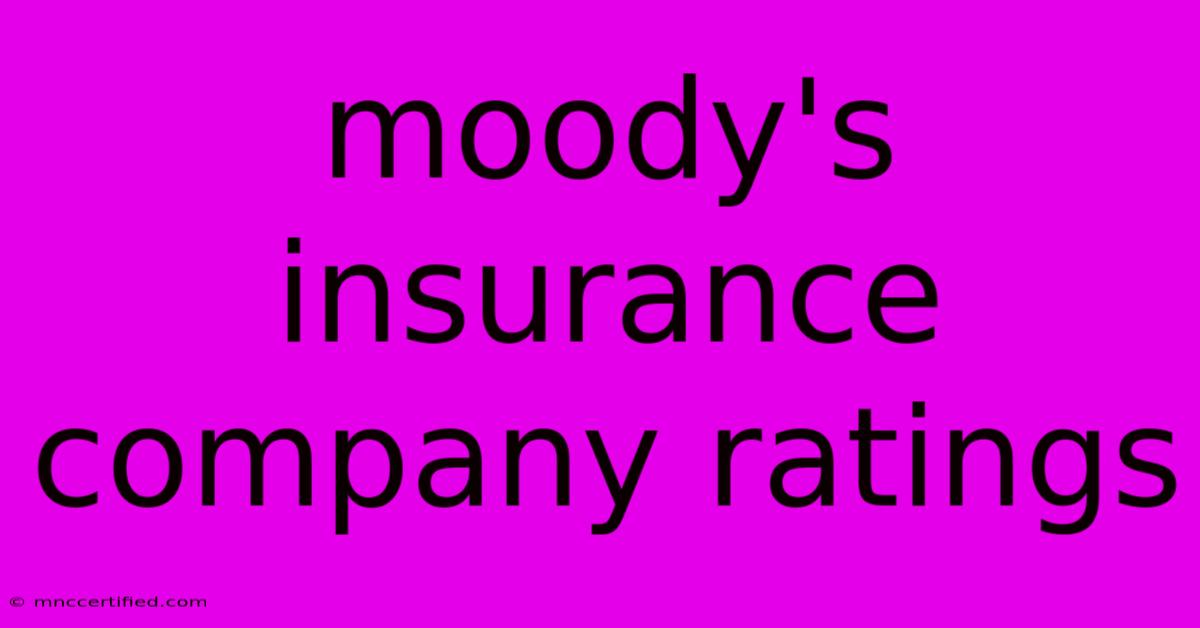Moody's Insurance Company Ratings

Table of Contents
Moody's Insurance Company Ratings: A Comprehensive Guide
Understanding the financial strength of an insurance company is crucial before purchasing a policy. One of the most trusted sources for this information is Moody's Investors Service, a leading global credit rating agency. This article provides a comprehensive guide to Moody's insurance company ratings, explaining their meaning, importance, and how to interpret them effectively.
What are Moody's Insurance Company Ratings?
Moody's assigns ratings to insurance companies based on a thorough assessment of their financial strength and creditworthiness. These ratings reflect the agency's opinion of an insurer's ability to meet its policy obligations and withstand various financial stresses. The ratings are vital for consumers, investors, and regulators alike.
Why are Moody's Ratings Important?
-
Consumer Protection: Choosing an insurer with a strong Moody's rating significantly reduces the risk of claims denials or company insolvency. A high rating suggests a greater likelihood of the insurer fulfilling its promises.
-
Investor Confidence: Moody's ratings influence investment decisions. Insurers with high ratings attract more investors, contributing to their financial stability.
-
Regulatory Oversight: Regulators use Moody's ratings to monitor the financial health of insurance companies and ensure consumer protection.
-
Competitive Advantage: A strong Moody's rating can be a significant competitive advantage for insurance companies, attracting more policyholders.
Understanding the Moody's Rating Scale
Moody's uses a letter-based rating scale, with "Aaa" representing the highest rating and "C" the lowest. Ratings below investment grade (Ba1/B1 and below) indicate high credit risk. Here's a simplified overview:
Investment Grade:
- Aaa: Exceptional financial strength; minimal credit risk.
- Aa: Very high financial strength; low credit risk.
- A: High financial strength; moderate credit risk.
- Baa: Moderate financial strength; somewhat higher credit risk.
Speculative Grade (Non-Investment Grade):
- Ba: Considerable vulnerability to default; substantial credit risk.
- B: High vulnerability to default; high credit risk.
- Caa: Very high vulnerability to default; very high credit risk.
- Ca: High risk of default.
- C: Default is imminent.
How Moody's Determines Insurance Company Ratings
Moody's employs a rigorous and multifaceted methodology to assess insurance companies, considering factors like:
-
Capital Adequacy: The amount of capital an insurer holds relative to its risk exposure. This is a critical factor in determining financial strength.
-
Underwriting Performance: The insurer's ability to profitably underwrite policies, minimizing losses.
-
Investment Portfolio: The quality and performance of the insurer's investment holdings.
-
Reserve Adequacy: The insurer's ability to accurately estimate and set aside sufficient funds to cover future claims.
-
Management Quality: The effectiveness and experience of the insurer's management team.
-
Liquidity: The insurer's ability to meet short-term obligations.
-
Geographic Diversification: Reducing risk by spreading business across different regions and lines of insurance.
-
Reinsurance: Utilization of reinsurance to transfer risk to other insurers.
Finding Moody's Insurance Ratings
While access to Moody's full rating reports often requires a subscription, you can find summaries and rating information for many major insurance companies through:
-
Moody's Website: The official Moody's website (www.moodys.com) provides some information, but complete access may require a subscription.
-
Insurance Company Websites: Many insurance companies prominently display their Moody's ratings on their websites.
-
Financial News Outlets: Major financial news websites and publications often report on insurance company ratings.
Conclusion: The Value of Understanding Moody's Ratings
Understanding Moody's insurance company ratings is an essential step in making informed decisions about insurance. By considering these ratings alongside other factors, you can better assess the financial stability and reliability of insurers, ultimately protecting your financial interests. Remember that while a high Moody's rating is a positive indicator, it's not the only factor to consider when choosing an insurance provider. It's always advisable to compare multiple insurers and carefully review policy details before making a final decision. Using this information responsibly helps improve consumer understanding and supports informed decisions in the insurance marketplace.

Thank you for visiting our website wich cover about Moody's Insurance Company Ratings. We hope the information provided has been useful to you. Feel free to contact us if you have any questions or need further assistance. See you next time and dont miss to bookmark.
Featured Posts
-
Croatia Vs Portugal Live Uefa Nations Stream
Nov 19, 2024
-
Farmers Auto Insurance Rental Car
Nov 19, 2024
-
Pregnant Lawrence Stuns At Governors Awards
Nov 19, 2024
-
Record Thanksgiving Travel 80 Million Projected
Nov 19, 2024
-
Broncos Defeat Yotes 4 0 Record
Nov 19, 2024